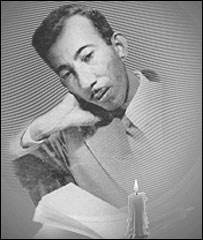
The Iraqi Poet Badr Shakir al-Sayyab
[Note: This is the ninth in a series of translations of selected letters of the noted Iraqi poet Badr Shakir al-Sayyab.]For more information on the poet, click here.]
Letter #9 5/7/1958
Baghdad:
My Dear Brother Dr. Suheil (Idris),
A most sincere Arab greeting to you,
You have, undoubtedly, asked yourself the reason for my prolonged silence. Like you, I ask myself the same question.
A whole year has passed, and I have only written two poems…. Sterility is seeping into my soul. Even when I write, I write only about this sterility. However, why do your readers need to endure the bitterness of this sterility of my soul, its barrenness and despair? It is truly a miracle that I am able to write – to write poetry of course. What offering can my arid soul impart?
In spite of that, today I am sending you a poem that contains a glimpse of optimism… it is merely a glimpse. Your magnificent translation of Camus’ masterpiece, “The Plague,†is a powerful expression of what I feel. Perhaps the Existentialists are somewhat right – when I apply their feelings to myself…. Nevertheless, man is a being with a history and a past. With this past and these roots comes hope… The roots of the past reach across the bald and dry trunk of the present to the top of the tree crowned with leaves, flowers and fruit. This is the window that the Existentialists did not attempt to open: from the past, the future is born through the present.
You notice in my poem (1) an attempt to return to the past, to our heritage. I have committed myself to a number of rhymes after exerting a major effort to liberate myself from multiple rhymes. As for the Babylonian symbols, I have only used them because of their richness and meaning. These symbols are still close to us, not only because they originated in the country where we live today or because the Babylonians were the cousins of our Arab grandfathers, but because the Arabs themselves have adopted these symbols.
From Abraham to the appearance of the great Arab Prophet, the Ka’ba has known all the Babylonian gods. Al-‘Uza is Astarte, al-Laat is al-Latu, Munat is Munaat and Wod is Tammuz or (Adon = Assayed) as he was sometimes called. Even the Arabs in the south have known these gods. Some Arab historians relate that Tammuz saw the people of Huran mourning him, but they referred to him as Ta’uz. Tammuz was also known in Yemen by the name of Ti’iz, and one of the cities in Yemen is still called by this name today. Ti’iz, the male, has a female counterpart known as al-‘Uza. It sometimes even seems to me that the people of ‘Aad and Thamud were the worshippers of Tammuz: ‘Aad or Aad – the letter ‘ayn and the hamza are interchangeable among some Semitic languages. ‘Aad = ‘Aadun who is Aadun: the master and Thamud is Tammuz.
Islam – the greatest victory achieved by Arab Nationalism – has come to uproot al-Laat, al-‘Uza, Wud , and many other idols that the Arabs had previously known. Today, when we use these symbols and refer to these idols by their Arabic names, we are in a way challenging Islam and, consequently, Arab Nationalism.
This is what drives us to return to the ancient origin of these symbols. Consequently, I do not deny that there are those who use these symbols merely because they are Babylonian (or Phoenician – in particular – there isn’t anyone among the Iraqis who feels that the Babylonians are closer to him than the Arabs. There isn’t actually anyone who feels that there is a bond – other than that of place- between him and the Babylonians.) In spite of this, there is no stipulation that we must only employ the symbols and legends that we have a bond with, be it through the environment, history or religion, while excluding those with which we have no tie at all. Anyone who goes back to Eliot’s celebrated poem, “The Waste Land,†learns that he employed Eastern pagan myths in order to express Christian ideas and Western cultural values.
Badr Shakir al-Sayyab
(1) It is evident that he refers here to his poem, “A Song in the Month of August.†The poet put a note in the margin of this letter from the beginning of this line and extended it to the end of the letter, instructing Dr. Idris as follows: “It is possible to publish this part of the letter in the discussion section. Mrs. Salma al-Jayyusi has previously broached the topic of employing Babylonian myths.â€
[From the book, al-Sayyab’s Letters, by Majid al-Samurra’i, (Beirut: Al-Mu’assasa al-‘Arabiya li-al-dirasat wa-al-Nashr, Second Edition, 1994, p. 132) Translated from the original Arabic and with an introduction by George Nicolas El-Hage, Ph.D., Columbia University.]